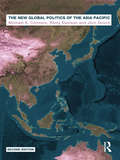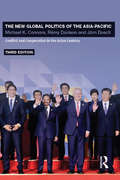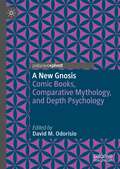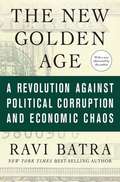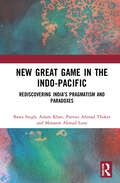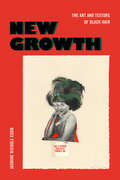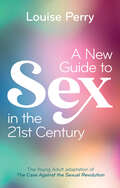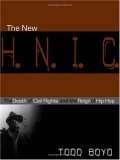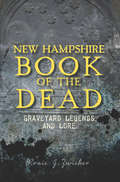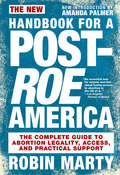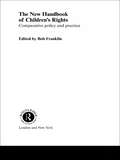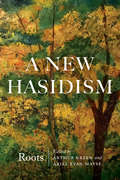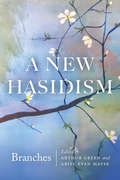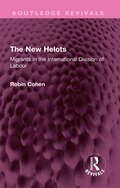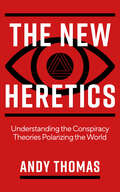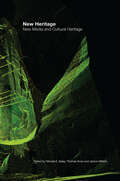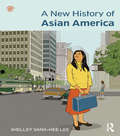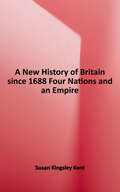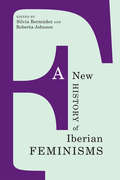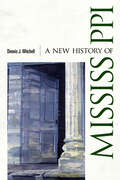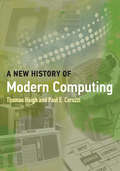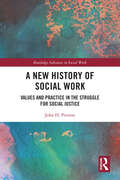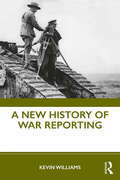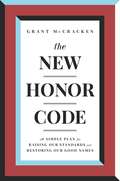- Table View
- List View
The New Global Politics of the Asia Pacific
by Michael K. Connors Rémy Davison Jörn DoschThe new, fully updated second edition of The New Global Politics of the Asia Pacific builds on its coherent framework for understanding the complex international and global politics of the Asia Pacific. The textbook provides an introductory guide for the main frameworks needed to understand the region (realism, liberalism, critical theory), which is reader-friendly while still offering sophisticated competing interpretations. Key content includes: the US in the Asia Pacific; China and Japan in the Asia Pacific; Southeast Asia in the Asia Pacific; India in the Asia Pacific; Russia in the Asia Pacific; Australia in the Asia Pacific; Europe in the Asia Pacific; globalization, regionalism and political economy; Asian values, democracy and human rights; transnational actors; region security order and the impact of terrorism on the region. ? A highly topical account, which provides an overview of the main actors, institutions and contemporary issues such as security, terrorism and transnational actors, the book is required reading for undergraduate students of Asian studies, international politics, and anyone interested in the region.
The New Global Politics of the Asia-Pacific: Conflict and Cooperation in the Asian Century
by Michael K. Connors Rémy Davison Jörn DoschNow in its new and fully updated third edition, The New Global Politics of the Asia Pacific continues to provide a compelling analysis of a region undergoing dramatic changes. Based on new research and offering fresh interpretation, this edition evaluates the prospects for continuing US dominance in the ‘Asian Century’. Whilst presenting evidence for a multifaceted ‘Beijing Strategy', which aims to counter the US by building an alternative regional order, it also explains Japan’s definitive departure from its limited military role. Providing an introductory guide for the main frameworks needed to understand the region, including realism, liberalism and critical theory, this new edition is reader-friendly, and offers sophisticated competing explanations. Key content includes: Intra-regional conflicts in the South China Sea and the Korean peninsula, The different responses within the Asia-Pacific to the globalization of Western ideas of democracy and political economy, The underappreciated success of the Association of Southeast Asian Nations in building a regional identity, The European Union’s soft power in the region. A highly topical account, which offers an overview of the main actors, institutions and contemporary issues in the Asia-Pacific, the book will be essential reading for undergraduate students of Asian Studies, International Politics, and anyone interested in the region.
A New Gnosis: Comic Books, Comparative Mythology, and Depth Psychology (Contemporary Religion and Popular Culture)
by David M. OdorisioSuperhero phenomena exploded into 20th- and 21st-century popular culture by way of the visual medium of comic books. In an increasingly secular (yet spiritual) culture that has largely renounced “the gods” (and even religion), what does the return of the superhero through our own pop cultural mythologies say to us—or even about us? This collection of essays from leading and up-and-coming scholars in the fields of comparative mythology and depth psychology considers the return of the superhero as representative of our own unique emergent modern mythology: a wildly diverse pantheon that reflects back to us our most far-reaching hopes and (im)possible (super)human desires. In placing the interpretive tools of comparative mythology and depth psychology alongside the comic book phenomenon, a super-powered palette emerges that unveils the hidden potential of modern readers’ own heightened imaginations. The essays in this anthology examine select comic book and superhero characters from the “Silver Age” 1960s through contemporary 21st-century adaptations and innovations, as readers are invited to discover and uncover what the (re)emergence of these perennial gods and goddesses have to say about our own secret super selves today.
The New Golden Age: The Coming Revolution against Political Corruption and Economic Chaos
by Ravi BatraBringing his signature insight and expertise, the controversial economist Ravi Batra takes on a host of problems facing the world economy, including the oil and housing bubbles, falling minimum wages, corporate scandals and gross ethical lapses.
New Great Game in the Indo-Pacific: Rediscovering India’s Pragmatism and Paradoxes
by Bawa Singh Aslam Khan Parvaiz Ahmad Thoker Mansoor Ahmad LoneThis book looks at the emerging power dynamics in the Indo-Pacific region and locates India and its interests within the overarching geostrategic framework. With US and China emerging as leading players within the region, the book analyses the challenges to India’s foreign policy in the face of new alliances, counter-alliances, and great power equations that have formed after the Cold War. It discusses important issues such as China’s strategic forays in the Indian Ocean, the balance of power between countries, India’s Act East opportunities, Russia’s re-engagement in the region, the South China Sea dispute, India’s maritime strategy, and the conundrum of the Quadrilateral Security Dialogue facing India. A comprehensive study of the changing geopolitical and geostrategic environment of the Indo-Pacific region, the book will be an essential read for scholars and researchers of international relations, global politics, foreign policy, maritime studies, Chinese studies, South Asian studies, geopolitics, and strategic studies.
New Growth: The Art and Texture of Black Hair (The Visual Arts of Africa and its Diasporas)
by Jasmine Nichole CobbFrom Frederick Douglass to Angela Davis, “natural hair” has been associated with the Black freedom struggle. In New Growth Jasmine Nichole Cobb traces the history of Afro-textured coiffure, exploring it as a visual material through which to reimagine the sensual experience of Blackness. Through close readings of slave narratives, scrapbooks, travel illustrations, documentary films, and photography as well as collage, craft, and sculpture, from the nineteenth century to the present, Cobb shows how the racial distinctions ascribed to people of African descent become simultaneously visible and tactile. Whether examining Soul Train’s and Ebony’s promotion of the Afro hairstyle alongside styling products or how artists such as Alison Saar and Lorna Simpson underscore the construction of Blackness through the representation of hair, Cobb foregrounds the inseparability of Black hair’s look and feel. Demonstrating that Blackness is palpable through appearance and feeling, Cobb reveals the various ways that people of African descent forge new relationships to the body, public space, and visual culture through the embrace of Black hair.
A New Guide to Sex in the 21st Century: The Young Adult Adaptation of 'The Case Against the Sexual Revolution'
by Louise PerryThe bestselling feminist book, now adapted for a young adult audienceBefore the 1960s, sex before marriage was frowned upon and pornography was difficult to get hold of. We are now much freer to do what we like – there has been a ‘sexual revolution’. This must be a good thing, right?Wrong, argues Louise Perry. These changes have had many negative consequences, especially for girls and women. The main winners from a world of rough sex, hook-ups and freely available porn are a tiny minority of rich and powerful men. Women have been forced to adapt to these changes in ways that often harm them.Louise Perry carefully guides readers through the difficulties of sex in the 21st century. Her advice will be invaluable to all young women and men who may be feeling lost in a world where ‘doing it’ can sometimes seem dangerous or confusing.
The New H.N.I.C.: The Death of Civil Rights and the Reign of Hip Hop
by Todd BoydFrames hip-hop as the defining cultural force in the aftermath of the Civil Rights and Black Power erasWhen Lauryn Hill stepped forward to accept her fifth Grammy Award in 1999, she paused as she collected the last trophy, and seeming somewhat startled said, “This is crazy, ‘cause this is hip hop music.’“ Hill’s astonishment at receiving mainstream acclaim for music once deemed insignificant testifies to the explosion of this truly revolutionary art form. Hip hop music and the culture that surrounds it—film, fashion, sports, and a whole way of being—has become the defining ethos for a generation. Its influence has spread from the state’s capital to the nation’s capital, from the Pineapple to the Big Apple, from ‘Frisco to Maine, and then on to Spain. But moving far beyond the music, hip hop has emerged as a social and cultural movement, displacing the ideas of the Civil Rights era. Todd Boyd maintains that a new generation, having grown up in the aftermath of both Civil Rights and Black Power, rejects these old school models and is instead asserting its own values and ideas. Hip hop is distinguished in this regard because it never attempted to go mainstream, but instead the mainstream came to hip hop.The New H.N.I.C., like hip hop itself, attempts to keep it real, and challenges conventional wisdom on a range of issues, from debates over use of the “N-word,” the comedy of Chris Rock, and the “get money” ethos of hip hop moguls like Sean “P. Diddy” Combs and Russell Simmons, to hip hop’s impact on a diverse array of figures from Bill Clinton and Eminem to Jennifer Lopez.Maintaining that Martin Luther King, Jr.’s “I Have a Dream” speech is less important today than DMX's It's Dark and Hell is Hot, Boyd argues that Civil Rights as a cultural force is dead, confined to a series of media images frozen in another time. Hip hop, on the other hand, represents the vanguard, and is the best way to grasp both our present and future.
New Hampshire Book of the Dead: Graveyard Legends and Lore
by Roxie J. ZwickerA historical journey through the headstones and hauntings of the Granite State—includes photos. New Hampshire&’s historic graveyards, from Portsmouth to North Conway, have bizarre and eerie stories to offer their visitors. Graveyards often invoke fear and superstition among the living, but the dead who rest within them may have more to communicate to the world they left behind. The sands of Pine Grove Cemetery in Hampton once concealed the tombstone of Susanna Smith, but now its message—which reads simply &“Slaine with thunder&”—and her story have risen from beneath the soil. The Point of Graves Cemetery in Portsmouth is home to the spirit of Elizabeth Pierce, who beckons departing guests back to her grave. Along the state&’s southern border in Jaffrey, tombstones at Philips-Heil Cemetery caution the living to cherish life. Here, Roxie Zwicker tours the Granite State&’s oldest burial grounds, exploring the stones, stories, and folklore of these hallowed places.
New Handbook for a Post-Roe America: The Complete Guide to Abortion Legality, Access, and Practical Support
by Robin MartyA completely new edition--with a new introduction by Amanda Palmer--of Robin Marty's best-selling manual on what to do if/when Roe v. Wade is overturned.The New Handbook for a Post-Roe America is a comprehensive and user-friendly manual for understanding and preparing for the looming changes to reproductive rights law, and getting the health care you need. Activist and writer Robin Marty guides readers through various worst-case scenarios of a post-Roe America, and offers ways to fight back, including: how to acquire financial support, how to use existing networks and create new ones, and how to, when required, work outside existing legal systems. She details how to plan for your own emergencies, how to start organizing now, what to know about self-managed abortion care with pills and/or herbs, and how to avoid surveillance. The only guidebook of its kind, The New Handbook for a Post-Roe America includes new chapters that cover the needs and tools available for pregnant people across the country. This second edition features extensively updated information on abortion legality and access in the United States, and approximately one hundred pages of new content, covering such topics as independent alternatives to Planned Parenthood, "auntie networks," taxpayer-funded abortions, and using social media wisely in the age of surveillance.
The New Handbook of Children's Rights: Comparative Policy and Practice
by Bob FranklinThe new edition of this well established handbook provides up-to-date information on a topic of increasing importance across a range of disciplines and practices. It covers:* the debate concerning children's rights and developments in rights provision over the last twenty years* the impact of recent British legislation on children's rights in key a
A New Hasidism: Roots
by Arthur Green Ariel Evan MayseNeo-Hasidism applies the Hasidic masters’ spiritual insights—of God’s presence everywhere, of seeking the magnificent within the everyday, in doing all things with love and joy, uplifting all of life to become a vehicle of God’s service—to contemporary Judaism, as practiced by men and women who do not live within the strictly bounded world of the Hasidic community. This first-ever anthology of Neo-Hasidic philosophy brings together the writings of its progenitors: five great twentieth-century European and American Jewish thinkers—Hillel Zeitlin, Martin Buber, Abraham Joshua Heschel, Shlomo Carlebach, and Zalman Schachter-Shalomi—plus a young Arthur Green. The thinkers reflect on the inner life of the individual and their dreams of creating a Neo-Hasidic spiritual community. The editors’ introductions and notes analyze each thinker’s contributions to Neo-Hasidic thought and influence on the movement. Zeitlin and Buber initiated a renewal of Hasidism for the modern world; Heschel’s work is quietly infused with Neo-Hasidic thought; Carlebach and Schachter-Shalomi re-created Neo-Hasidism for American Jews in the 1960s; and Green is the first American-born Jewish thinker fully identified with the movement. Previously unpublished materials by Carlebach and Schachter-Shalomi include an interview with Schachter-Shalomi about his decision to leave Chabad-Lubavitch and embark on his own Neo-Hasidic path.
A New Hasidism: Branches
by Arthur Green Ariel Evan MayseYou are invited to enter the new-old pathway of Neo-Hasidism—a movement that uplifts key elements of Hasidism’s Jewish revival of two centuries ago to reexamine the meaning of existence, see everything anew, and bring the world as it is and as it can be closer together. This volume brings this discussion into the twenty-first century, highlighting Neo-Hasidic approaches to key issues of our time. Eighteen contributions by leading Neo-Hasidic thinkers open with the credos of Zalman Schachter-Shalomi and Arthur Green. Or Rose wrestles with reinterpreting the rebbes’ harsh teachings concerning non-Jews. Ebn Leader assesses the perils of trusting one’s whole being to a single personality: can Neo-Hasidism endure as a living tradition without a rebbe? Shaul Magid candidly calibrates Shlomo Carlebach: how “the singing rabbi” transformed him and why Magid eventually walked away. Other contributors engage questions such as: How might women enter this hitherto gendered sphere created by and for men? How can we honor and draw nourishment from other religions’ teachings? Can the rebbes’ radiant wisdom guide those who struggle with self-diminishment to reclaim wholeness? Together these intellectually honest and spiritually robust conversations inspire us to grapple anew with Judaism’s legacy and future.
The New Helots: Migrants in the International Division of Labour (Routledge Revivals)
by Robin CohenOriginally published in 1987 and now reissued with a substantial introduction by Robin Cohen, this wide-ranging work of comparative and historical sociology argues that a major engine of capital’s growth lies in its ability to find successive cohorts of quasi-free workers to deploy in the farms, mines and factories of an expanding international division of labour. These workers, like the helots of ancient Greece, are found at the periphery of ‘regional political economies’ or in the form of modern migrants, sucked into the vortex of metropolitan service or manufacturing industry. The regions of Southern Africa; the USA and the circum-Caribbean; European and its colonial and southern hinterlands, are systematically compared – yielding original and, in some cases, uncomfortable analogies between countries previously thought to be wholly different in terms of their political structures and guiding values. The New Helots has been written with both an undergraduate and professional readership in mind. Students of history, sociology and economics as well as those interested in patterns of migration and ethnic relations will find it of interest.
The New Heretics: Understanding the Conspiracy Theories Polarizing the World
by Andy ThomasThis is the most balanced and well-reasoned investigation available into why people believe today&’s highly divisive conspiracy theories, from COVID and QAnon to 5G scares, fake news and more.Through their part in some huge controversies, conspiracy theorists are being branded the Number One Enemies of our times – the new heretics. They are seen to threaten the very fabric of modern society, spreading doubts and fears that result in Washington Capitol invasions, transmission mast burnings or the spread of anti-vaxx material. Yet the theorists prefer to call themselves "truth seekers" and see the mainstream establishment as the real disruptor, treating its increasingly harsh censorship as direct validation of their views. In truth, the new heretics, whose numbers are swelling, are symptoms of a wider polarization splitting apart much of the world in ideological divisions. Many have lost trust in politicians and the media, while nuanced debate is crushed and information overload and manipulation breeds uncertainty, civil unrest and mental health issues. How does the age old strategy of divide-and-rule play out in such an environment? Using his extensive experience of negotiating disputes between cynics and truth seekers, Andy Thomas explores the proliferation of conspiracy thinking, peeling back unhelpful layers of biased thinking on all sides to find more insightful ways to bridge the polarised divides and create a better way forward.
New Heritage: New Media and Cultural Heritage
by Thomas Kvan Yehuda Kalay Janice AffleckThe use of new media in the service of cultural heritage is a fast growing field, known variously as virtual or digital heritage. New Heritage, under this denomination, broadens the definition of the field to address the complexity of cultural heritage such as the related social, political and economic issues. This book is a collection of 20 key essays, of authors from 11 countries, representing a wide range of professions including architecture, philosophy, history, cultural heritage management, new media, museology and computer science, which examine the application of new media to cultural heritage from a different points of view. Issues surrounding heritage interpretation to the public and the attempts to capture the essence of both tangible (buildings, monuments) and intangible (customs, rituals) cultural heritage are investigated in a series of innovative case studies.
New Histories of the Andaman Islands
by Anderson, Clare and Mazumdar, Madhumita and Pandya, Vishvajit Clare Anderson Madhumita Mazumdar Vishvajit PandyaThis innovative, multidisciplinary exploration of the unique history of the Andaman Islands as a hunter-gatherer society, colonial penal colony, and state-engineered space of settlement and development ranges across the theoretical, conceptual and thematic concerns of history, anthropology and historical geography. Covering the entire period of post-settlement Andamans history, from the first (failed) British occupation of the Islands in the 1790s up to the year 2012, the authors examine imperial histories of expansion and colonization, decolonization, anti-colonialism and nationalism, Japanese occupation, independence and partition, migration, commemoration and contemporary issues of Indigenous welfare. New Histories of the Andaman Islands offers a new way of thinking about the history of South Asia, and will be thought-provoking reading for scholars of settler colonial societies in other contexts, as well as those engaged in studies of nationalism and postcolonial state formation, ecology, visual cultures and the politics of representation.
A New History of Asian America
by Shelley Sang-Hee LeeA New History of Asian America is a fresh and up-to-date history of Asians in the United States from the late eighteenth century to the present. Drawing on current scholarship, Shelley Lee brings forward the many strands of Asian American history, highlighting the distinctive nature of the Asian American experience while placing the narrative in the context of the major trajectories and turning points of U.S. history. Covering the history of Filipinos, Koreans, Asian Indians, and Southeast Indians as well as Chinese and Japanese, the book gives full attention to the diversity within Asian America. A robust companion website features additional resources for students, including primary documents, a timeline, links, videos, and an image gallery. From the building of the transcontinental railroad to the celebrity of Jeremy Lin, people of Asian descent have been involved in and affected by the history of America. A New History of Asian America gives twenty-first-century students a clear, comprehensive, and contemporary introduction to this vital history.
A New History of Britain Since 1688: Four Nations and an Empire
by Susan Kingsley Kent"Based on the most current scholarship concerning gender, race, ethnicity, and empire, this 15-chapter textbook comprehensively examines the development ot and contestations against a British identity among the constituent parts of the United Kingdom since 1688. It takes seriously the role of Scotland, Wales, and Ireland in this process, and brings Britain's imperial subjects and lands into the narrative, showing how integral empire was to the UK's historical development. It examines the role environmental factors in economic development and their impact on the health and welfare of British citizens and subjects; and it uses gender, in particular, to illuminate power dynamics across a variety of settings. All this in a manageable length"--Provided by publisher.
A New History of Iberian Feminisms (Toronto Iberic)
by Silvia Bermudez Roberta JohnsonA New History of Iberian Feminisms is both a chronological history and an analytical discussion of feminist thought in the Iberian Peninsula, including Portugal, and the territories of Spain – the Basque Provinces, Catalonia, and Galicia – from the eighteenth century to the present day. The Iberian Peninsula encompasses a dynamic and fraught history of feminism that had to contend with entrenched tradition and a dominant Catholic Church. Editors Silvia Bermúdez and Roberta Johnson and their contributors reveal the long and historical struggles of women living within various parts of the Iberian Peninsula to achieve full citizenship. A New History of Iberian Feminisms comprises a great deal of new scholarship, including nineteenth-century essays written by women on the topic of equality. By addressing these lost texts of feminist thought, Bermúdez, Johnson, and their contributors reveal that female equality, considered a dormant topic in the early nineteenth century, was very much part of the political conversation, and helped to launch the new feminist wave in the second half of the century.
A New History of Mississippi
by Dennis J. MitchellCreating the first comprehensive narrative of Mississippi since the bicentennial history was published in 1976, Dennis J. Mitchell recounts the vibrant and turbulent history of a Deep South state. The author has condensed the massive scholarship produced since that time into an appealing narrative, which incorporates people missing from many previous histories including American Indians, women, African Americans, and a diversity of other minority groups. This is the story of a place and its people, history makers and ordinary citizens alike. Mississippi's rich flora and fauna are also central to the story, which follows both natural and man-made destruction and the major efforts to restore and defend rare untouched areas. Hernando De Soto, Sieur d’Iberville, Ferdinand Claiborne, Thomas Hinds, Aaron Burr, Greenwood LeFlore, Joseph Davis, Nathan Bedford Forrest, James D. Lynch, James K. Vardaman, Mary Grace Quackenbos, Ida B. Wells, William Alexander Percy, William Faulkner, Eudora Welty, Muddy Waters, B.B. King, Elvis Presley, John Grisham, Jack Reed, William F. Winter, Jim Barksdale, Richard Howorth, Christopher Epps, and too many more to list—this book covers a vast and rich legacy. From the rise and fall of American Indian culture to the advent of Mississippi’s world-renowned literary, artistic, and scientific contributions, Mitchell vividly brings to life the individuals and institutions that have created a fascinating and diverse state.
A New History of Modern Computing (History of Computing)
by Thomas Haigh Paul E. CeruzziHow the computer became universal.Over the past fifty years, the computer has been transformed from a hulking scientific supertool and data processing workhorse, remote from the experiences of ordinary people, to a diverse family of devices that billions rely on to play games, shop, stream music and movies, communicate, and count their steps. In A New History of Modern Computing, Thomas Haigh and Paul Ceruzzi trace these changes. A comprehensive reimagining of Ceruzzi's A History of Modern Computing, this new volume uses each chapter to recount one such transformation, describing how a particular community of users and producers remade the computer into something new. Haigh and Ceruzzi ground their accounts of these computing revolutions in the longer and deeper history of computing technology. They begin with the story of the 1945 ENIAC computer, which introduced the vocabulary of "programs" and "programming," and proceed through email, pocket calculators, personal computers, the World Wide Web, videogames, smart phones, and our current world of computers everywhere--in phones, cars, appliances, watches, and more. Finally, they consider the Tesla Model S as an object that simultaneously embodies many strands of computing.
A New History of Social Work: Values and Practice in the Struggle for Social Justice (Routledge Advances in Social Work)
by John H. PiersonThis book provides an overview of the main developments in social work over its 200-year history. From its beginnings in the early 19th century through to the present day, it recounts the efforts to create a fairer, socially just society through its work with individuals and families. Throughout, by focusing on individual cases as well as major ideas behind practice, this book invites the reader to step into the practitioner’s world as it unfolded. Providing a fresh, critical history of social work in Britain, the book covers the practical assistance for families and individuals in poverty in the 19th century; women’s social work with destitute mothers and children; social work’s response to war time needs; the development of specific domains of social work such as hospital social work, psychiatric social workers, moral welfare and children in care; tackling racism; and social work in a market society. The reader encounters the society that social workers and their users wrote about, thought about and sought to create. Covering critical points of dispute along with overarching visions that would take the profession – and society – forward, the book explores the ideologies, moral constructs and social forces that shaped everyday social work. A New History of Social Work will be of interest to all scholars and students of social work and will be particularly relevant for modules on introductions to social work and the foundations of social work.
A New History of War Reporting
by Kevin WilliamsThis book takes a fresh look at the history of war reporting to understand how new technology, new ways of waging war and new media conditions are changing the role and work of today’s war correspondent. Focussing on the mechanics of war reporting and the logistical and institutional pressures on correspondents, the book further examines the role of war propaganda, accreditation and news management in shaping the evolution of the specialism. Previously neglected conflicts and correspondents are reclaimed and wars considered as key moments in the history of war reporting such as the Crimean War (1854-56) and the Great War (1914-18) are re-evaluated. The use of objectivity as the yardstick by which to assess the performance of war correspondents is questioned. The emphasis is instead placed on war as a messy business which confronts reporters and photographers with conditions that challenge the norms of professional practice. References to the ‘demise of the war correspondent’ have accompanied the growth of the specialism since the days of William Howard Russell, the so-called father of war reporting. This highlights the fragile nature of this sub-genre of journalism and emphasises that continuity as much as change characterises the work of the war correspondent. A thematically organised, historically rich introduction, this book is ideal for students of journalism, media and communication.
The New Honor Code: A Simple Plan for Raising Our Standards and Restoring Our Good Names
by Grant McCrackenCultural anthropologist and thought leader Grant McCracken proposes a radical solution for our time of unprecedented scandal: a return to honor. What used to be shocking has somehow become the new normal in our politics, workplaces, and universities. Sexual predators stalk interns at work and teenagers abroad. Parents try to buy a place for their kids in college. Pharmaceutical companies refuse to acknowledge the Opioid epidemic they helped create. Banks issue credit cards no one ordered, ruining the credit scores and reputations of thousands. It happens so frequently that we can no longer dismiss these cases as a few bad apples. Clearly, something in the system is rotten. Most Americans are committed to morality. We share basic standards of decency. And yet, we&’re becoming inured to scandal and shame, and hopeless about the possibility of change. What if we decided to fight it instead? Grant McCracken has a solution—the revival of an ancient idea called honor. Once the moral compass of millions of people for hundreds of years, it has since fallen out of currency just when we need it the most. Grant looks at honor and dishonor as these are expressed in popular culture and at institutions as diverse as Harvard, PBS, and Wells Fargo. He offers practical guidelines for both organizations and individuals looking to restore moral order to their lives.
